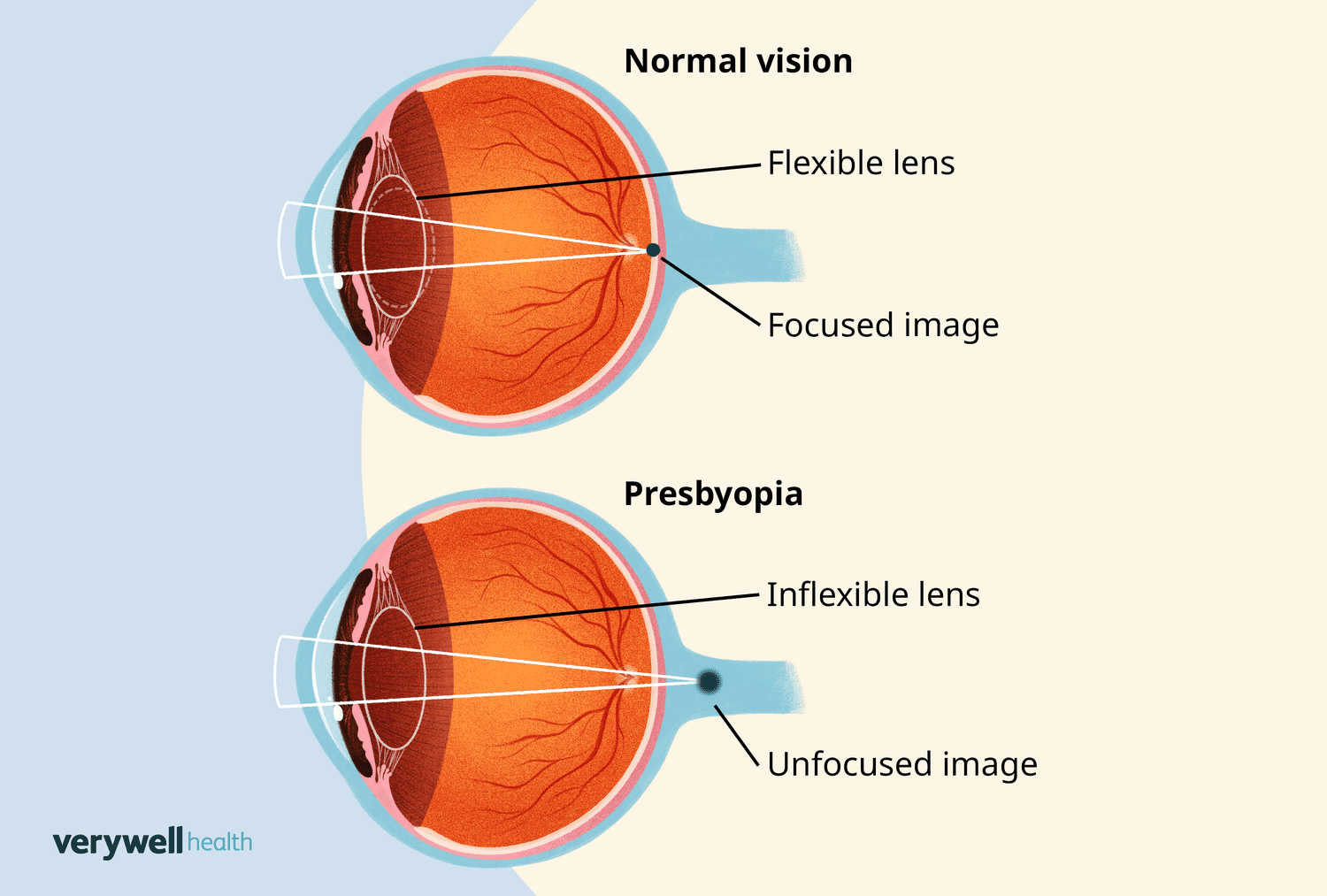As we age, many people encounter presbyopia, a vision condition that typically manifests around the age of 40. This condition is characterized by difficulty in seeing objects clearly up close, often requiring individuals to hold reading materials at an arm’s length. Presbyopia affects nearly everyone, making it a prevalent concern among those in their middle ages and beyond. Fortunately, various corrective strategies, such as eyeglasses, contact lenses, and even surgical options, are available to help manage this condition.
:max_bytes(150000):strip_icc():format(webp)/VWH-Presbyopia-How-Aging-Affects-Your-Vision-TEXT-FINAL-1-1-5d3c0e9f966443ef94194f82f0743498.png)
Understanding Presbyopia
Presbyopia is classified as a refractive error, which occurs when the eye fails to focus light appropriately on the retina—the light-sensing layer at the back of the eye. Other common refractive errors include nearsightedness, farsightedness, and astigmatism. As we age, changes in the lens of the eye lead to this challenge in focusing for near tasks.
When Do Symptoms of Presbyopia Begin?
Most individuals start noticing symptoms of presbyopia after the age of 40. The progression of visual change generally continues until around age 65 when it reaches its peak impact. The term “presbyopia” derives from Greek, meaning “old eye,” which aptly describes the age-related nature of the condition.
The Mechanism Behind Age-Related Farsightedness
As we grow older, the lens located at the front of the eye undergoes changes that affect its flexibility. This lens is responsible for adjusting the focus of light rays onto the retina. In younger individuals, small muscles attached to the lens can easily shape it for different distances. However, with age, these muscles weaken, and the lens stiffens, making it challenging to focus on nearby objects. Consequently, activities like reading or detailed work become problematic.
Those who are already farsighted may find that presbyopia begins to affect them sooner since their eyes are already overexerting to see things clearly at close range. Conversely, individuals with nearsightedness often maintain good near vision despite aging, but they will struggle with distance vision if they need corrective lenses.
Myopia vs. Hyperopia
With myopia, objects that are far away look blurry because the eye is longer than usual from front to back. As a result, light rays land in front of the light-sensitive retina instead of directly on it, making it difficult to clearly see things that are a ways away.
Hyperopia causes light rays to land in front of the retina, making objects up close look blurry. It can occur because the eye is shorter than usual. It may also occur if there’s an issue with the lens or the clear cornea at the front of the eye.
Symptoms of Presbyopia: Recognizing the Signs
If you are over 40 and begin to experience difficulty with tasks that require near vision, you may be developing presbyopia. Common symptoms include:
- Difficulty discerning fine details up close
- Uncomfortably extending your arms to read fine print
- Experiencing eye strain and discomfort after engaging in close-up tasks
- Frequent headaches due to eye muscle tension
- A heightened need for adequate lighting when reading
- Requiring larger print to comfortably read text
Getting Your Vision Checked
To diagnose presbyopia and other vision issues, a comprehensive eye exam performed by an ophthalmologist or optometrist is essential. These specialists can prescribe corrective measures like glasses or contact lenses. If you’re seeking a qualified eye doctor, the National Eye Institute recommends using resources to find a reputable optometrist or ophthalmologist.
Treatment Options for Presbyopia
While there is no way to reverse presbyopia due to the rigidity of the lens, various corrective options exist to improve near vision:
Eyeglasses: Reading glasses are a simple solution for presbyopia, focusing light correctly onto the retina. Consultation with an eye specialist can determine the best magnification needed.
Bifocals and Trifocals: Bifocal lenses combine two prescriptions for near and distance vision, while trifocal lenses add an intermediate vision correction. Progressive lenses offer a gradual transition between different powers without visible lines.
Contact Lenses:
- Monovision Contacts: These lenses use one eye for distance and the other for close-up vision. Users may need time to adjust.
- Multifocal Contacts: These contain varying powers to accommodate different viewing distances.
- Surgical Options: Procedures like LASIK can reshape the cornea to provide monovision correction. Corneal inlays, approved by the FDA, are another method to improve near vision by implanting a small device in the eye.
A Word From Verywell
For most cases of presbyopia in which people do not require glasses for distance but require them for up-close reading, I usually do not recommend LASIK correction because they tend to regress very quickly, within one or two years. For people who wear contacts or glasses for up-close reading but lose the ability to read, LASIK is an option with monovision correction.
Potential Side Effects and Considerations
Unmanaged presbyopia can lead to discomfort, including eye strain and headaches. Depending on individual circumstances, some people may face additional risks when considering corrective surgery. Conditions such as diabetes, dry eyes, thin corneas, keratoconus, advanced glaucoma, cataracts, and even pregnancy can complicate the candidacy for surgical procedures.
Adapting to Vision Changes
As you navigate the progression of presbyopia, consider these strategies:
- Regularly updating your prescription for reading glasses or bifocals.
- Exploring monovision contact lenses for improved near and distance vision.
- Using eye drops that may help enhance near vision temporarily.
Conclusion
In summary, presbyopia is a common age-related vision challenge that begins to affect individuals typically around their 40s. While it can complicate daily tasks and lead to visual discomfort, prompt corrective options—such as eyeglasses or contact lenses—can significantly enhance your quality of life. If you begin to notice any symptoms, consult an eye care professional to discuss your options.
Read More From Source link
Discover more from Marki Mugan
Subscribe to get the latest posts sent to your email.









